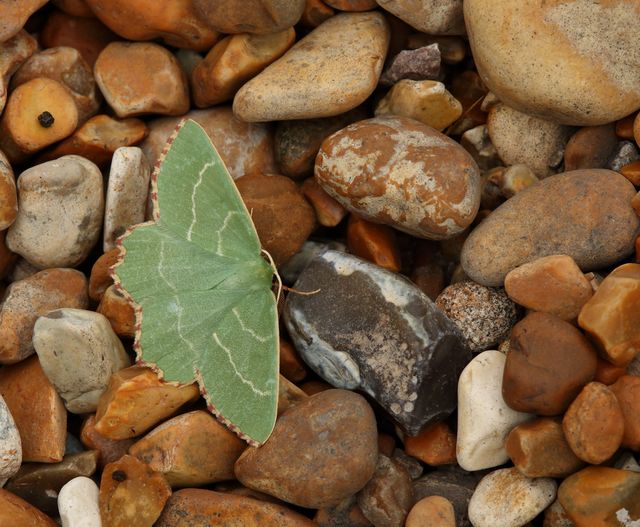Multiple Sussex Emerald moths have been found at Stodmarsh National Nature Reserve this July. This suggests a breeding population may be present and follows the first sighting of an individual Sussex Emerald moth, discovered here by Kent Moth Group in 2018.
Butterfly Conservation had originally joined Natural England volunteers at Stodmarsh NNR to monitor another rare moth species that lives here; the Bright Wave. The team were delighted to find multiple Sussex Emerald moths living here too, due to their rarity and unusual location. Their UK population has been limited to a select few areas of the Kent and East Sussex coasts until now. They are facing multiple threats along their coastal sites. Availability of their very specific vegetated shingle habitat has reduced with large rabbit populations consuming Wild Carrot; their main foodplant. This combined with issues of invasive plants and increased development pressures along the coast, threaten the moth’s specific habitat areas. The moth is also vulnerable to increasingly frequent droughts which further reduces the survival of their foodplants.
Stefan Barton, responsible for the discovery site belonging to Natural England, said “Nature is always full of surprises, the discovery of the Sussex Emerald was one I never thought would happen given the distance from us to their nearest known breeding site. This discovery just goes to show the importance of our survey efforts at Stodmarsh NNR and the work we do to help conserve our native species. It’s been a year of many first recordings at Stodmarsh through our different surveys and who knows what else is out there that we have yet to find and record on our reserve”
Kent’s Magnificent Moths
The survey at this site is part of work from the Kent’s Magnificent Moths Project, a three-year project in East Kent, that aims to save some of the UK’s rarest moths. The project, funded by the National Lottery Heritage Fund, works against a range of threats facing the moths of this region including development pressure, changing land management, and climate change. The Sussex Emerald is one of eight priority species that the project is working to protect.
Rebecca Levey, Kent’s Magnificent Moths Conservation Officer, commented “Finding these moths surrounded by their larval foodplant at Stodmarsh NNR suggests this moth is breeding at inland sites in Kent for the very first time. Wild Carrot is not a rare wildflower species inland though. Until now it has been the species’ exclusivity to vegetated shingle habitat areas that has been limiting their ability to move away from the threats they face along the coast. If increased monitoring efforts lead to us finding that Sussex Emeralds can successfully breed in new habitat types, more people across Kent could start encountering these beautiful moths in the coming years.”
The Sussex Emerald is a stunning member of the Emerald Moths (part of the Geometridae family) within which this species can be identified by their red chequered wing fringes. Butterfly Conservation has monitored its fluctuating abundance over the last 20 years and these moths very occasionally turn up as migrants elsewhere, with the only breeding populations found along the Kent and East Sussex Coastlines.
But wait… there’s more
We can’t know for certain that Stodmarsh NNR is a confirmed breeding site until we find Sussex Emerald caterpillars here. Come May 2023, we will be embarking on a big caterpillar hunt with Natural England, to hopefully discover this species and be certain that this is the first time the Sussex Emerald has bred away from the coast.
Everyone is welcome to join in this search, for those interested in taking part in our habitat creation and caterpillar search efforts, please contact Rebecca Levey at @email.
With thanks to the National Lottery Heritage Fund who provide invaluable support to many projects throughout Butterfly Conservation.
Moths Matter!



